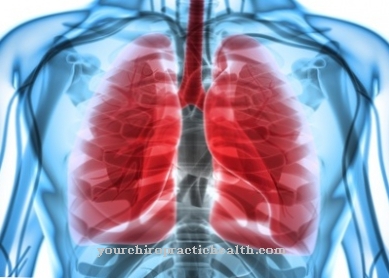Of the Lacrimation of a person is a natural and important process. The healthy functioning of tear formation is of considerable importance not only for physical but also for mental health.
What is tear flow?

Tear flow is generally understood to mean the formation of a mirror-smooth tear film that is protective over the cornea of the eye. The tear fluid is continuously formed by the lacrimal glands and the Krausschen and Wolfring's glands, which are called accessory glands.
The secretion contains enzymes, ions, lipids, ketone bodies, serum proteins and other components that are distributed over the eyeball by movements of the eyelids. It is transported away by flowing through the tear and nasal passages into the nasal cavity. A much smaller part of the secretion evaporates.
Tears are usually associated with crying, in which a larger amount of tear secretion is reflexively secreted from the lacrimal apparatus. Crying is either triggered by physiological stimuli as a protective measure or occurs in response to a strong emotional stimulus.
The normal level of tear production can be checked by the so-called Schirmer test. A strip of special paper is wedged into the lower crease of the eyelid for five minutes, where it soaks up the liquid. In this way it can be determined whether the value is in the normal range.
Function & task
The film of tear fluid ensures a sharp projection of light rays onto the retina of the eyes and is therefore an important factor for visual acuity. A drying out of the cornea is avoided by the secretion is permanently distributed on the cornea. This distribution takes place through the blink of an eye, which is colloquially referred to as blinking or blinking.
On average, a person winks 10 to 15 times per minute, with their eyelids usually reflexively closing and reopening at a very rapid pace, unnoticed and involuntarily. The tear fluid prevents the eyelids from rubbing against the eyeballs. If the glands increasingly produce tear secretions, which are washed over the edge of the eyelids, this serves to protect the body. Foreign bodies and highly irritating substances, such as the essential oils of an onion or a speck of dust, are washed out of the eye.
The signal for the increased formation of the required tear fluid is reported by the sensory cells on the conjunctiva via biochemical messenger substances to the parasympathetic nervous system. This part of the brain then causes the glands to form massive secretions, which disinfect the eyes with the lysozyme it contains. The extremely complex process of reflex crying serves to maintain eyesight.
Crying as an emotional form of expression produces tears that are increasingly enriched with hormones such as prolactin and endorphins as well as proteins, potassium and manganese. Numerous studies deal with the question of whether this should be interpreted as a sign that the body is attempting to detoxify. So far there is no consensus on this thesis.
The fact is, however, that emotional crying is usually felt to be psychologically relieving. It is also used for social interaction and communication. Particularly noteworthy in this context is the ability of an infant to win the affection of its caregiver through crying. The extent to which the ability to cry is maintained into adulthood depends largely on the upbringing, as the experiences learned are stored in the cells of the cerebellum.
You can find your medication here
➔ Medicines for eye infectionsIllnesses & ailments
If the flow of tears is disturbed, this inevitably leads to physical and emotional impairment of well-being. Dry eyes lead to irritation of the eye due to the friction caused by blinking. An incessant feeling of a foreign body can be the result, which in turn can trigger increased blinking. The protective function is reduced and the eye is susceptible to infection, since the germicidal effect of the tear fluid is missing. Even eyesight can be impaired if the glands do not produce enough secretions.
If the eyes are too dry because the permanent tear production does not work, reflex crying often sets in, because the conjunctiva perceives the irritation of the eye and initiates the process of massive tear formation.
Dry eyes and excessively watery eyes are therefore not mutually exclusive. First of all, you should always look for the cause of watery eyes. If an ophthalmologist determines an underlying disease or causal injury, this should be treated with a professional.
Common triggers for dry or increasingly watery eyes include allergies, the use of certain medications, conjunctivitis, irritants such as cigarette smoke or excessive work at the screen. Diseases such as gout, asthma, diabetes or thyroid diseases are less common causes.
Anatomical features can also be considered. In rare cases, the draining tear ducts can be narrowed and have to be opened surgically. The lacrimal glands can even become inflamed or tumors from an infection or systemic diseases.
Inflammation can also develop in the bags under the eyes that are located at the inner corner of the eye and open into the nasal passages. Many people who have had an eyelid surgery later experience dry eyes. The tear ducts with the so-called teardrop points are extremely sensitive and should not be manipulated if possible.
It is always advisable to see a specialist in ophthalmology if you experience problems with your eyes. The specialist makes the diagnosis and initiates the necessary therapy.
























.jpg)



